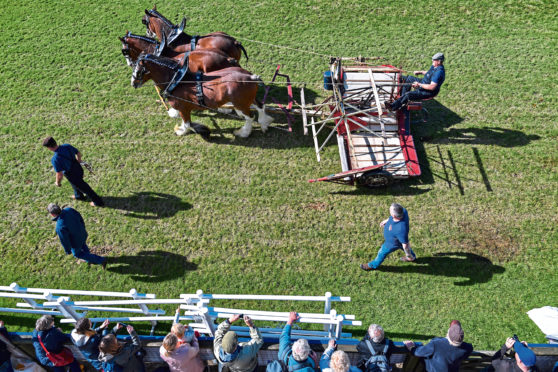Over a year in the planning, the Celebration of the Clydesdale, saw huge crowds line the Royal Highland Show ring, watch from the grandstand, pack the members stand and seek views from numerous other vantage points at the Ingliston showground.
What they saw was a history of how the Clydesdale Horse has been used in farming, forestry and in the towns and cities throughout the world – as well as featuring their present-day uses.
The idea came from Benny Duncan from Balmalcolm in Fife with further input from George Skinner of the Strathorn Stables at Inverurie.
Once given the go ahead from the Clydesdale Horse Society (CHS), an approach was made to the Royal Highland and Agricultural Society of Scotland which was keen to support the occasion with sponsorship arrangements and other financial support was also secured.
Contact was made with fellow enthusiasts to guarantee enough horses broken to harness and enough manpower to lead and drive the horses. Then implements were sourced and paired with suitable horses and their owners.
From then on it was all hands on deck to prepare the vast range of farm machinery needed to tell the story of Scotland’s premier draught horse.
With tight main ring schedules to keep to, it was going to be a nerve-wracking time to get everyone hitched up and ready in the collecting area.
The camaraderie of the heavy horse fraternity came to the fore as plenty willing hands manhandled the machinery out of the superb interpretive display area out into the collecting area for an easier hitch up.
This was done in front of huge crowds as excitement grew amongst everyone, including the horses.
Then the waiting was over as the parade entered the ring led by the CHS vice-president and secretary setting the pace.
First it was the Clydesdale stallion which represented the days when travelling stallions hired by local agricultural organisations went from farm to farm improving local horse populations, represented by the following mare and foal.
Starting with the plough a pair hitched to a Ransomes “Guid Top” example designed specifically for Scottish conditions commenced the farming year. A set of horse drawn disc harrows followed to represent cultivation equipment.
Several differing types of soil engaging implements, however, had to be left behind because of the inability to drag them round the grass surface.
A Ben Reid of Aberdeen flat roller came next while an American Hoosier grain drill told the cereal establishment chapter.
Planting potatoes was represented by a drill plough followed by a rare Kydd of Coupar Angus 2 row potato planter.
To apply fertiliser was the Wallace of Castle Douglas distributor. Turnip sowing saw a Gordon of Castle Douglas drill enter the ring and for cleaning the crop was a set of Ballach of Leith scarifiers.
Moving to the hay season saw a Deering mower and a pair of horses followed by a Bamford of Uttoxeter hay turner.
The typically Scottish “Tumlin Tam” followed, to gather the hay up for building coles or rucks, followed the Nicholson of Newark rake.
With three horses on the pole, the McCormick binder evoked many harvest memories of the past as this iconic machine glided across the hallowed Ingliston turf. Following this was the harvest cart sometimes known as a Jenny Lind after the popular Swedish opera singer of the 19th Century.
The more mundane box cart was next, ideal for carting tatties and turnips back to the farm. This was a very clever machine being so finely balanced it could tip its load by the application of the horseman’s shoulder.
Meanwhile, highlighting the work in towns, factories, railway stations, and dock sides was the horse lorry.
The decorated harness class came next as the parade moved into the modern day with a Ridden Clydesdale followed by a Concourse De Elegance and the Ladies Cart with finely turned out horses and humans.
The parade closed with two Scottish police horses doing what they do best ushering the parade out of the ring to allow the Strathorn Stables Musical Ride finale.
With the huge applause of the appreciative crowd the celebration ended with all the enthusiasts and the show directors delighted with the impact of the spectacle. It begs the question how will it be followed up?
